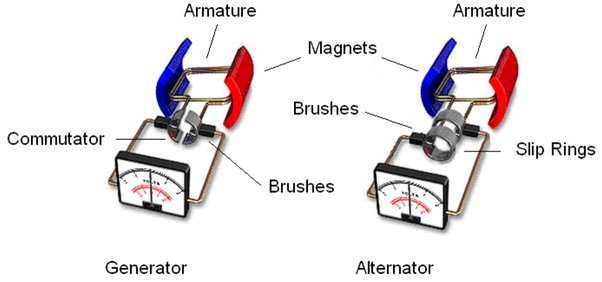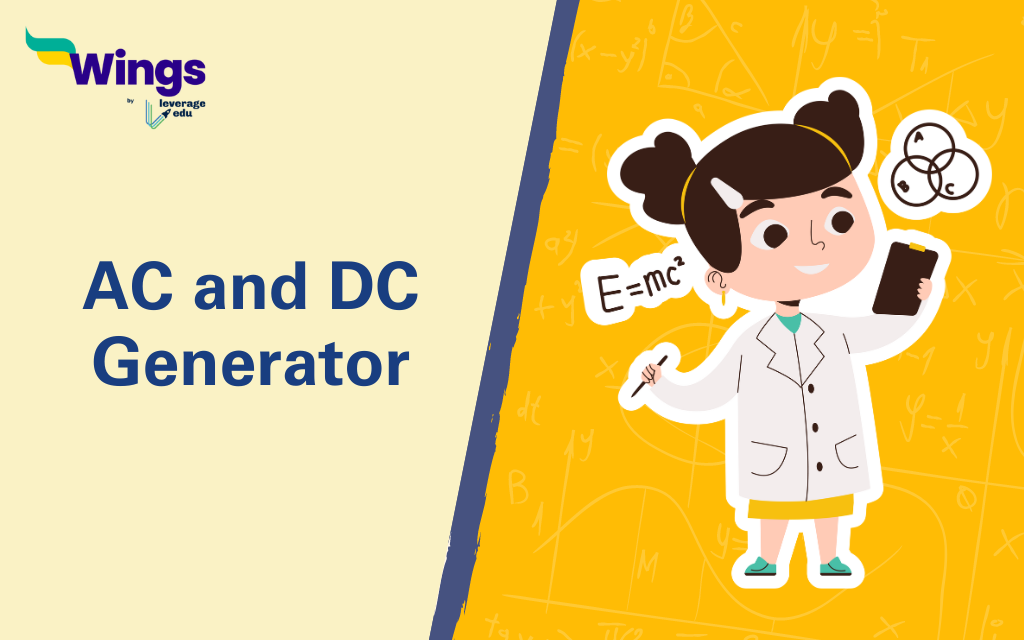Generators or electrical generators are the powerhouse of electricity that converts mechanical energy into electrical energy. The invisible flow of electricity that powers our lives originates from generators. However, not all generators are created equal. Within these generators, there are two types of generators – AC Generators and DC Generators.
While both the two generators produce electricity, they are different in their output and applications. An AC generator uses an electromagnet while a DC generator uses a permanent magnet. AC generators use commutators, while DC generators use slip rings. In this blog, we will get to know all about AC and DC generators, their applications, working, uses and many more. But first, let us get to know what are ac and dc generators.
Contents
| Feature | AC Generator | DC Generator |
| Current Type | Alternating Current | Direct Current |
| Output | Current constantly changes direction | Current flows in one direction only |
| Applications | Power grids, wind turbines, hydroelectric plants | Battery charging, electroplating, specialized machinery |
| Rotating Part | Conductor (armature) | Conductor (armature) |
| Magnetic Field | Stationary (stator) | Can be stationary or rotate |
| Current Collection | Slip rings | Commutator |
Also Read – Balanced Force: Definition, Example and Characteristics
What are AC Generators?
AC generators are used for large-scale electricity production. Their design allows for a smooth transmission of electricity over long distances. An AC generator is based on the principle of Faraday’s Law of Electromagnetic Induction (EMI). This law states that an EMF (electromagnetic force) or voltage-producing current-carrying conductor can be produced by rotating a stationary conducting coil. Here is the core principle:
A rotating loop of conductor (armature) spins within a stationary magnetic field (stator). This motion induces a constantly changing, or alternating current in the conductor. Transformers can then step up the voltage for long-distance transmission and step it down for safe household use.
Applications of AC Generators:
- Power Grids: AC is the standard for power grids due to the ease of voltage manipulation. This allows for efficient transmission over vast distances with minimal energy loss.
- Wind Turbines: The wind spins the turbine blades, which act as the armature of an AC generator, producing clean electricity.
- Hydroelectric Plants: The force of falling water spins turbines connected to AC generators, converting hydropower into electricity.

What are DC Generators?
DC generators are less common for large-scale power production and are used only for crucial purposes in specific applications. Their key feature is a commutator, a rotating switch-like device, that ensures a constant unidirectional current flow. A DC generator works on the principle of energetic induction electromotive force (EMF). When a conductor reduces its magnetic flux, it generates an EMF-based on Faraday’s electromagnetic induction principle. The EMF is produced when a closed conductor circuit produces current.
Applications of DC Generators:
- Battery Charging: DC generators are used to charge batteries in vehicles, powering electric cars and providing backup power.
- Electroplating: DC is important for electroplating, a process that uses electricity to deposit a thin layer of metal onto a surface.
- Specialized Equipment: DC generators are often used in machinery and control systems where precise, unidirectional current is needed.
Also Read – DC Generator: Parts, Working Principles, EMF Equation
Similarities between AC and DC Generators
As both generators work on similar principles. There are many similarities between AC and DC generators. They are –
- Energy Conversion: Both AC and DC generators function on the principle of electromagnetic induction, converting mechanical energy (like the spin of a turbine) into electrical energy.
- Rotating Component: Both have a rotating part called the armature, which consists of a conductor that moves within a magnetic field.
- Magnetic Field: Both utilize a magnetic field to induce current flow in the conductor. This magnetic field can be stationary or rotate.
- Basic Construction: Both generators share a similar core design with a rotating armature and a stationary or rotating magnetic field. Both require an external circuit to complete the flow of electricity generated.
- Power Source: Both can be driven by various mechanical sources like wind turbines, water turbines, or combustion engines. Both require regular maintenance to ensure smooth operation and prevent breakdowns.
The environmental impact of both generators depends on the source of the mechanical energy driving them. Renewable sources like wind or hydro minimize environmental impact. Both AC and DC generators play an important role in electricity production, each serving distinct purposes within the power grid.
How are AC and DC Generators Different?
The DC generators are different from AC generators by the following points –
- Current Flow: The key difference lies in the current itself. AC generators produce a constantly reversing current, while DC generators produce a current that flows in one direction only.
- Applications: AC generators dominate large-scale power transmission due to the ease of manipulating voltage for long-distance travel. DC generators excel in specific applications requiring a steady, unidirectional current.
- Current Collection: AC generators use slip rings and simple sliding contacts, to collect current from the rotating armature. DC generators utilize a commutator, a rotating switch-like device, to ensure unidirectional current flow.
- Complexity: DC generators tend to be slightly more complex due to the presence of the commutator, which requires maintenance and can wear down over time.
- Transmission Efficiency: AC current can be transmitted over long distances with minimal energy loss through transformers, which can step up voltage for transmission and step it down for safe household use. DC transmission is less efficient over long distances.
- Cost: AC generators are generally less expensive due to their simpler design compared to DC generators with commutators.
- Maintenance Needs: The presence of the commutator in DC generators increases maintenance requirements compared to AC generators with slip rings.
- Voltage Regulation: AC voltage can be easily controlled and regulated using transformers, making AC generators suitable for various applications with varying voltage needs. Regulating DC voltage is more complex.
- Sparking: The commutator in DC generators can cause sparking during operation, requiring specific considerations for safe use in certain environments. AC generators using slip rings experience minimal sparking.
- Applications in Daily Life: AC is the dominant form of electricity powering our homes and businesses. DC plays a vital role in specific applications like battery charging, electroplating, and specialized control systems.
FAQs
In an alternating current (AC) generator, the current flows from side to side on a regular basis. In a direct current (DC) generator, the electric current only flows in one direction.
The main difference between an AC and DC generator is that an AC generator uses an electromagnet, while a DC generator uses a permanent magnet. A DC generator will produce a higher voltage.
A rectifier is a device that uses alternating current (AC) to convert direct current (DC) which only flows in one direction.
The rectifier inside your laptop’s power adapter is responsible for converting AC power to DC power. Most electronic devices (including laptops) use DC power because it ensures a constant, stable flow of electricity.
Related Blogs
Hope this blog helps you understand AC and DC Generators. Keep reading more of our blogs to learn about the basic concepts of Physics!
 One app for all your study abroad needs
One app for all your study abroad needs














